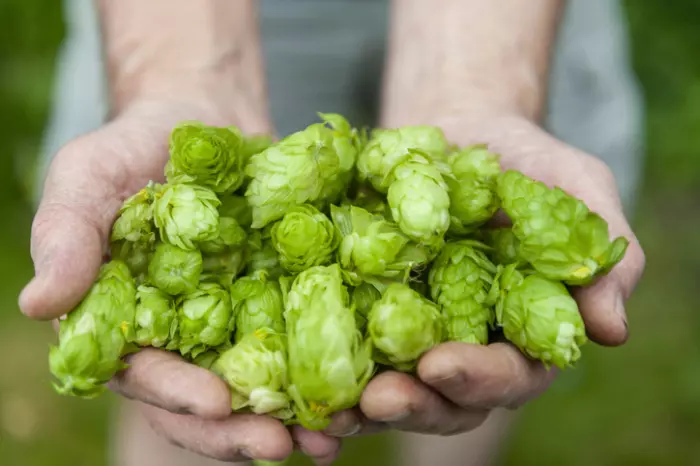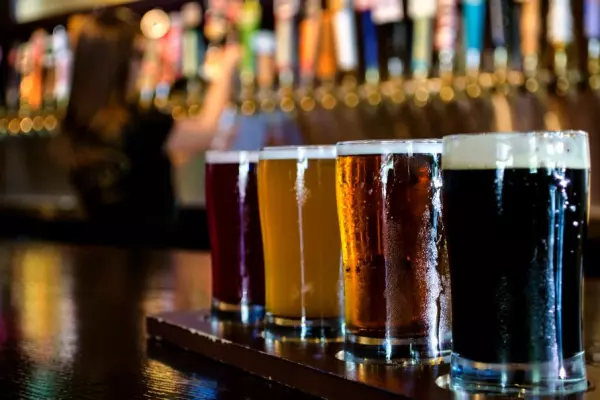Like grapes, hops are harvested in early autumn. We don’t see the evidence of the grape harvest until much later in the year when the season’s vintage is released, but with hops, “harvest” beers are hitting the shelves now.
These beers are much different from the year-round offerings because they are made with unprocessed, newly picked, “fresh” hops.
To make sure hops are available year-round for brewing, the bulk of them are dried, processed into pellets and sealed into vacuum packs to stay in good condition. Part of this processing removes a lot of the green leafy material.
Increasingly in New Zealand, however, a fraction of the harvest remains unprocessed and is used in a growing number of “fresh hop” beers.
The idea of celebrating the hop harvest in New Zealand is relatively new. Tracy Banner – now owner and master brewer of Sprig + Fern Brewery in Richmond –was one of the early adopters when she created Brewjolais for Mac’s in nearby Nelson in the 1990s.
For a long time, fresh hop beers were the preserve of brewers close to Nelson, because newly picked hops can start to turn brown within 24 hours. It wasn’t so long ago that brewers in Wellington started chartering planes to get to Nelson, load up on freshly picked hops and head back to their bases to start making beer the same day.
Transport issues and logistics used to be barriers for brewers further afield, but the past two years has seen a rapid change in both technology and logistics. It’s been discovered that the hops last longer when chilled straight off the bine (yes, the bine – the climbing or twining stem of the hop plant – not vine). The pre-chilled hops can be at their best for three days if they stay cold. That’s allowed New Zealand’s biggest producer, NZ Hops Ltd, to send pre-chilled hops to designated pick-up venues in Upper Hutt (Kererū Brewing) and Auckland (Behemoth) so breweries in the North Island can go and get them.
That change in practice has seen the fresh hop phenomenon spread much further afield than in previous years; NZ Hops calculates that a record 35 breweries used its green hops this year.
A good example is Brave Brewing in Hastings, where founder-brewer Matt Smith had previously always found it hard to get his hands on fresh hops. This year, he flew to Wellington, hired a car, drove to Kererū, picked up his allocation and was back in Hastings that afternoon to start brewing. The hops were around three days old when he used them in his Helping Hands IPA, but they were in great condition, he said.
“NZ Hops have made a lot of improvements over the years. They pick them and they go straight into coolrooms to pre-cool before they start their journey. They go into the refrigerated truck cold and stay cold.”
Many breweries also deal direct with individual farms for quick pick-up and delivery.
Luke Nicholas of Epic Beer in Onehunga says his Haze Fever IPA featured hops that were on the bine at 5am and in the brew kettle early that afternoon. “Our friend from Eggers Hop Farm in the Moutere Valley was up at 5am picking the hops so we could get them into the brew as fast as possible. The hops were delivered to Nelson Airport by 7am, were in Auckland by noon and into the brew by 2pm the same day.”
The growth of fresh hop beers is reflected in New World’s record number of such offerings, with 18 on the shelves, including 8 Wired, Baylands, Behemoth, Deep Creek, Double Vision, Eddyline, Epic, Garage Project, Good George, Panhead, Parrotdog, Renaissance, Sawmill and Urbanaut.
Urbanaut is one of the most adventurous fresh hop breweries in the country, and this year is the second time it’s made a six-pack with six different fresh hop beers. Each showcases a different hop variety and a different beer style — Saison (Pacifica), India Pale Lager (Nelson Sauvin), Brut IPA (Motueka), Hazy Pale Ale (Nectaron), West Coast IPA (Waimea) and Hazy Double IPA (Cascade).
Brewing with fresh hops is notoriously hard and — from a business perspective — inefficient. The pillow-like hops soak up so much beer that yields are lower than on normal brew days and the saturated hops clog up systems and make things difficult to clean. So, to brew six different fresh hop beers is a massive undertaking.
But Urbanaut founder Bruce Turner’s view is that this is a special time of the year for beer lovers and it’s worth celebrating.
“The beautiful thing is we’re so lucky because there are not many countries in the world where you can brew fresh hop beers with top-grade commercial hops.
“It’s only New Zealand, Australia, parts of the US, the hop belt in Europe — if you’re not close enough to fresh hops, you can’t have the privilege of making these beers.”
So, what’s different about a fresh hop beer? There’s often an oily resinous quality to the mouthfeel and the aroma has a sprightly, delicate, fresh-from-the-garden pungency. It’s not quite as striking as the difference you find between dried and fresh herbs but it’s comparable. Dried herbs have a more concentrated, intense flavour than fresh herbs, and so it is with hops. Compare a mint tea made with fresh mint from the garden versus dried-mint tea.
But as with anything fresh and one-off, you have to be in quick as there’s only a limited volume of these beers and they won’t last long.
Follow Michael @hoppiness.co.nz














